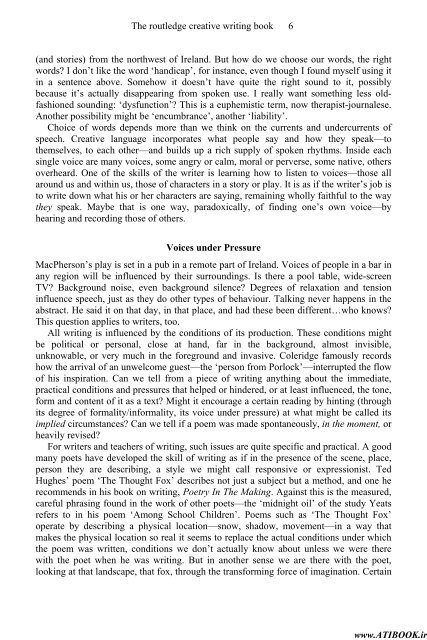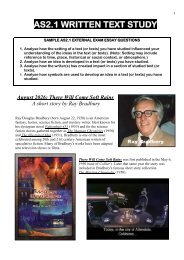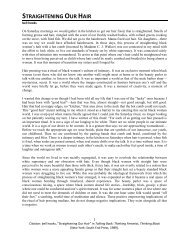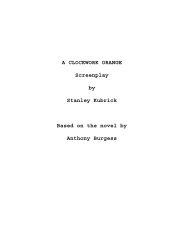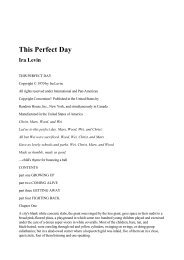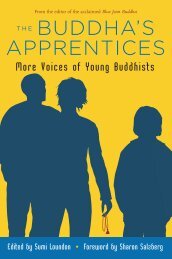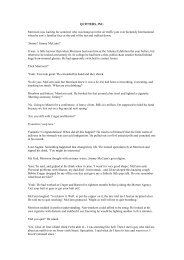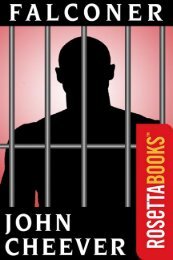www.ATIBOOK.irWriting as art 5‘Verona,’ Kathy would say, ‘I’d love to spend a few days in Verona.’And <strong>the</strong>n for a long while <strong>the</strong>y would talk about Verona, <strong>the</strong> things <strong>the</strong>ywould see and do, trying to make it real in <strong>the</strong>ir minds. All around <strong>the</strong>m<strong>the</strong> fog moved in low and fat off <strong>the</strong> lake, and <strong>the</strong>ir voices would seem toflow away for a time and <strong>the</strong>n return to <strong>the</strong>m from somewhere in <strong>the</strong>woods beyond <strong>the</strong> porch…They would go on talking about <strong>the</strong> fine old churches of Verona, <strong>the</strong>museums and outdoor cafes where <strong>the</strong>y would drink strong coffee and eatpastries. They invented happy stories for each o<strong>the</strong>r A late-night train-rideto Florence, or maybe north into <strong>the</strong> mountains, or maybe Venice, and<strong>the</strong>n back to Verona, where <strong>the</strong>re was no defeat and nothing in real lifeever ended badly. For both of <strong>the</strong>m it was a wishing game. Theyenvisioned happiness as a physical place on <strong>the</strong> earth, a secret country,perhaps, or an exotic foreign capital with bizarre customs and a differentnew language. To live <strong>the</strong>re would require practice and many changes, but<strong>the</strong>y were willing to learn.(O’Brien, 1995:2–3)These two characters create a world—<strong>the</strong>y call it ‘Verona’—simply by talking about it. Itbecomes <strong>the</strong>ir own ‘secret country’ an ‘envisioned happiness’. It’s important, of course,that <strong>the</strong>y don’t actually go to <strong>the</strong> real place, don’t make actual, practical plans. Would<strong>the</strong>y agree with <strong>the</strong> author’s explanation—that <strong>the</strong>ir talk hardly amounts to more than ‘awishing game’? They probably would. His voice overlaps with <strong>the</strong>irs. They half-know,half-suspect this Verona is an evasion, an easy escape-route. From what? They probablywouldn’t be willing or ready to say. Voices can be used to show concealment; sometimesthis is precisely what speech is about.This merging of <strong>the</strong> writer’s voice with <strong>the</strong> voices of characters in fiction is known asfree indirect speech, a valuable device in third person narrative, as shown above. Asreaders it keeps our attention where it should be, not on <strong>the</strong> writer’s views and opinions,but on <strong>the</strong> characters in <strong>the</strong> story. We listen to <strong>the</strong>m, engage with what is happening in<strong>the</strong>ir minds below <strong>the</strong> level of conscious, articulate speech. The writer enables us to see,hear and feel <strong>the</strong>ir hidden sensations, first intimations (for example) of doubt or of desire,before <strong>the</strong>se become conscious or can be spoken about directly.Finding a VoiceIf <strong>creative</strong> language frequently makes use of voiced forms, does this mean each writer isburdened with <strong>the</strong> quest to discover his or her unique voice, something expressly originalamong this huge polyphony of voices? The notion of ‘your own voice’, ‘finding a voice’,refers to a writer’s stance towards all <strong>the</strong> <strong>creative</strong> features of <strong>writing</strong> as art, including, ofcourse, voice itself. Your voice will be generated by what you write about, <strong>the</strong> recurrentplaces, aspects and qualities of <strong>the</strong> world you represent, by <strong>the</strong> images you choose tohighlight, <strong>the</strong> types of story or story-like events that hold for you a special fascination.Some readers might think certain idioms, slang expressions and regional speechqualities to be a handicap. To o<strong>the</strong>rs <strong>the</strong> possession of an accent suggests vitality. ConorMacPherson’s play The Weir (see Chapter 6, p. 214) is a play written to celebrate voices
www.ATIBOOK.irThe <strong>routledge</strong> <strong>creative</strong> <strong>writing</strong> book 6(and stories) from <strong>the</strong> northwest of Ireland. But how do we choose our words, <strong>the</strong> rightwords? I don’t like <strong>the</strong> word ‘handicap’, for instance, even though I found myself using itin a sentence above. Somehow it doesn’t have quite <strong>the</strong> right sound to it, possiblybecause it’s actually disappearing from spoken use. I really want something less oldfashionedsounding: ‘dysfunction’? This is a euphemistic term, now <strong>the</strong>rapist-journalese.Ano<strong>the</strong>r possibility might be ‘encumbrance’, ano<strong>the</strong>r ‘liability’.Choice of words depends more than we think on <strong>the</strong> currents and undercurrents ofspeech. Creative language incorporates what people say and how <strong>the</strong>y speak—to<strong>the</strong>mselves, to each o<strong>the</strong>r—and builds up a rich supply of spoken rhythms. Inside eachsingle voice are many voices, some angry or calm, moral or perverse, some native, o<strong>the</strong>rsoverheard. One of <strong>the</strong> skills of <strong>the</strong> writer is learning how to listen to voices—those allaround us and within us, those of characters in a story or play. It is as if <strong>the</strong> writer’s job isto write down what his or her characters are saying, remaining wholly faithful to <strong>the</strong> way<strong>the</strong>y speak. Maybe that is one way, paradoxically, of finding one’s own voice—byhearing and recording those of o<strong>the</strong>rs.Voices under PressureMacPherson’s play is set in a pub in a remote part of Ireland. Voices of people in a bar inany region will be influenced by <strong>the</strong>ir surroundings. Is <strong>the</strong>re a pool table, wide-screenTV? Background noise, even background silence? Degrees of relaxation and tensioninfluence speech, just as <strong>the</strong>y do o<strong>the</strong>r types of behaviour. Talking never happens in <strong>the</strong>abstract. He said it on that day, in that place, and had <strong>the</strong>se been different…who knows?This question applies to writers, too.All <strong>writing</strong> is influenced by <strong>the</strong> conditions of its production. These conditions mightbe political or personal, close at hand, far in <strong>the</strong> background, almost invisible,unknowable, or very much in <strong>the</strong> foreground and invasive. Coleridge famously recordshow <strong>the</strong> arrival of an unwelcome guest—<strong>the</strong> ‘person from Porlock’—interrupted <strong>the</strong> flowof his inspiration. Can we tell from a piece of <strong>writing</strong> anything about <strong>the</strong> immediate,practical conditions and pressures that helped or hindered, or at least influenced, <strong>the</strong> tone,form and content of it as a text? Might it encourage a certain reading by hinting (throughits degree of formality/informality, its voice under pressure) at what might be called itsimplied circumstances? Can we tell if a poem was made spontaneously, in <strong>the</strong> moment, orheavily revised?For writers and teachers of <strong>writing</strong>, such issues are quite specific and practical. A goodmany poets have developed <strong>the</strong> skill of <strong>writing</strong> as if in <strong>the</strong> presence of <strong>the</strong> scene, place,person <strong>the</strong>y are describing, a style we might call responsive or expressionist. TedHughes’ poem ‘The Thought Fox’ describes not just a subject but a method, and one herecommends in his book on <strong>writing</strong>, Poetry In The Making. Against this is <strong>the</strong> measured,careful phrasing found in <strong>the</strong> work of o<strong>the</strong>r poets—<strong>the</strong> ‘midnight oil’ of <strong>the</strong> study Yeatsrefers to in his poem ‘Among School Children’. Poems such as ‘The Thought Fox’operate by describing a physical location—snow, shadow, movement—in a way thatmakes <strong>the</strong> physical location so real it seems to replace <strong>the</strong> actual conditions under which<strong>the</strong> poem was written, conditions we don’t actually know about unless we were <strong>the</strong>rewith <strong>the</strong> poet when he was <strong>writing</strong>. But in ano<strong>the</strong>r sense we are <strong>the</strong>re with <strong>the</strong> poet,looking at that landscape, that fox, through <strong>the</strong> transforming force of imagination. Certain
- Page 1 and 2: www.ATIBOOK.ir
- Page 3 and 4: www.ATIBOOK.ir
- Page 5 and 6: www.ATIBOOK.irFirst published 2006
- Page 7 and 8: www.ATIBOOK.ir
- Page 9 and 10: www.ATIBOOK.irPREFACESomewhere betw
- Page 11 and 12: Miroslav Holub, ‘The Fly’, from
- Page 13 and 14: www.ATIBOOK.irThe routledge creativ
- Page 15: www.ATIBOOK.irThe routledge creativ
- Page 19 and 20: www.ATIBOOK.irThe routledge creativ
- Page 21 and 22: www.ATIBOOK.irThe routledge creativ
- Page 23 and 24: www.ATIBOOK.irThe routledge creativ
- Page 25 and 26: www.ATIBOOK.irThe routledge creativ
- Page 27 and 28: www.ATIBOOK.irThe routledge creativ
- Page 29 and 30: www.ATIBOOK.irThe routledge creativ
- Page 31 and 32: www.ATIBOOK.irThe routledge creativ
- Page 33 and 34: www.ATIBOOK.irThe routledge creativ
- Page 35 and 36: www.ATIBOOK.irThe routledge creativ
- Page 37 and 38: www.ATIBOOK.irThe routledge creativ
- Page 39 and 40: www.ATIBOOK.irThe routledge creativ
- Page 41 and 42: www.ATIBOOK.irThe routledge creativ
- Page 43 and 44: www.ATIBOOK.irThe routledge creativ
- Page 45 and 46: www.ATIBOOK.irThe routledge creativ
- Page 47 and 48: www.ATIBOOK.irCHAPTER 2PERSONAL NAR
- Page 49 and 50: www.ATIBOOK.irThe routledge creativ
- Page 51 and 52: www.ATIBOOK.irThe routledge creativ
- Page 53 and 54: www.ATIBOOK.irThe routledge creativ
- Page 55 and 56: www.ATIBOOK.irThe routledge creativ
- Page 57 and 58: www.ATIBOOK.irThe routledge creativ
- Page 59 and 60: www.ATIBOOK.irThe routledge creativ
- Page 61 and 62: www.ATIBOOK.irThe routledge creativ
- Page 63 and 64: www.ATIBOOK.irThe routledge creativ
- Page 65 and 66: www.ATIBOOK.irThe routledge creativ
- Page 67 and 68:
www.ATIBOOK.irThe routledge creativ
- Page 69 and 70:
www.ATIBOOK.irThe routledge creativ
- Page 71 and 72:
www.ATIBOOK.irThe routledge creativ
- Page 73 and 74:
www.ATIBOOK.irThe routledge creativ
- Page 75 and 76:
www.ATIBOOK.irThe routledge creativ
- Page 77 and 78:
www.ATIBOOK.irThe routledge creativ
- Page 79 and 80:
www.ATIBOOK.irThe routledge creativ
- Page 81 and 82:
www.ATIBOOK.irThe routledge creativ
- Page 83 and 84:
www.ATIBOOK.irThe routledge creativ
- Page 85 and 86:
www.ATIBOOK.irThe routledge creativ
- Page 87 and 88:
www.ATIBOOK.irThe routledge creativ
- Page 89 and 90:
www.ATIBOOK.irThe routledge creativ
- Page 91 and 92:
www.ATIBOOK.irThe routledge creativ
- Page 93 and 94:
www.ATIBOOK.irThe routledge creativ
- Page 95 and 96:
www.ATIBOOK.irThe routledge creativ
- Page 97 and 98:
www.ATIBOOK.irThe routledge creativ
- Page 99 and 100:
www.ATIBOOK.irThe routledge creativ
- Page 101 and 102:
www.ATIBOOK.irThe routledge creativ
- Page 103 and 104:
www.ATIBOOK.irThe routledge creativ
- Page 105 and 106:
www.ATIBOOK.irThe routledge creativ
- Page 107 and 108:
www.ATIBOOK.irThe routledge creativ
- Page 109 and 110:
www.ATIBOOK.irThe routledge creativ
- Page 111 and 112:
www.ATIBOOK.irThe routledge creativ
- Page 113 and 114:
www.ATIBOOK.irThe routledge creativ
- Page 115 and 116:
www.ATIBOOK.irThe routledge creativ
- Page 117 and 118:
www.ATIBOOK.irThe routledge creativ
- Page 119 and 120:
www.ATIBOOK.irThe routledge creativ
- Page 121 and 122:
www.ATIBOOK.irThe routledge creativ
- Page 123 and 124:
www.ATIBOOK.irThe routledge creativ
- Page 125 and 126:
www.ATIBOOK.irThe routledge creativ
- Page 127 and 128:
www.ATIBOOK.irThe routledge creativ
- Page 129 and 130:
www.ATIBOOK.irThe routledge creativ
- Page 131 and 132:
www.ATIBOOK.irThe routledge creativ
- Page 133 and 134:
www.ATIBOOK.irThe routledge creativ
- Page 135 and 136:
www.ATIBOOK.irThe routledge creativ
- Page 137 and 138:
www.ATIBOOK.irThe routledge creativ
- Page 139 and 140:
www.ATIBOOK.irThe routledge creativ
- Page 141 and 142:
www.ATIBOOK.irThe routledge creativ
- Page 143 and 144:
www.ATIBOOK.irCHAPTER 5CHILDREN’S
- Page 145 and 146:
www.ATIBOOK.irThe routledge creativ
- Page 147 and 148:
www.ATIBOOK.irThe routledge creativ
- Page 149 and 150:
www.ATIBOOK.irThe routledge creativ
- Page 151 and 152:
www.ATIBOOK.irThe routledge creativ
- Page 153 and 154:
www.ATIBOOK.irThe routledge creativ
- Page 155 and 156:
www.ATIBOOK.irThe routledge creativ
- Page 157 and 158:
www.ATIBOOK.irThe routledge creativ
- Page 159 and 160:
www.ATIBOOK.irThe routledge creativ
- Page 161 and 162:
www.ATIBOOK.irThe routledge creativ
- Page 163 and 164:
www.ATIBOOK.irThe routledge creativ
- Page 165 and 166:
www.ATIBOOK.irCHAPTER 6DRAMADrama a
- Page 167 and 168:
www.ATIBOOK.irThe routledge creativ
- Page 169 and 170:
www.ATIBOOK.irThe routledge creativ
- Page 171 and 172:
www.ATIBOOK.irThe routledge creativ
- Page 173 and 174:
www.ATIBOOK.irThe routledge creativ
- Page 175 and 176:
www.ATIBOOK.irThe routledge creativ
- Page 177 and 178:
www.ATIBOOK.irThe routledge creativ
- Page 179 and 180:
www.ATIBOOK.irThe routledge creativ
- Page 181 and 182:
www.ATIBOOK.irThe routledge creativ
- Page 183 and 184:
www.ATIBOOK.irThe routledge creativ
- Page 185 and 186:
www.ATIBOOK.irThe routledge creativ
- Page 187 and 188:
www.ATIBOOK.irThe routledge creativ
- Page 189 and 190:
www.ATIBOOK.irThe routledge creativ
- Page 191 and 192:
www.ATIBOOK.irThe routledge creativ
- Page 193 and 194:
www.ATIBOOK.irThe routledge creativ
- Page 195 and 196:
www.ATIBOOK.irThe routledge creativ
- Page 197 and 198:
www.ATIBOOK.irThe routledge creativ
- Page 199 and 200:
www.ATIBOOK.irThe routledge creativ
- Page 201 and 202:
www.ATIBOOK.irGlossary 190a piece o
- Page 203 and 204:
www.ATIBOOK.irGlossary 192Point of
- Page 205 and 206:
www.ATIBOOK.irBIBLIOGRAPHYTitles re
- Page 207 and 208:
www.ATIBOOK.irBibliography 196McCul
- Page 209 and 210:
www.ATIBOOK.irBibliography 198Penn,
- Page 211 and 212:
www.ATIBOOK.irIndex 200Bible 4, 107
- Page 213 and 214:
www.ATIBOOK.irIndex 202‘WHAM’ (
- Page 215 and 216:
www.ATIBOOK.irIndex 204in the creat
- Page 217 and 218:
www.ATIBOOK.irIndex 206O’Brien, T
- Page 219:
www.ATIBOOK.irIndex 208and persona


